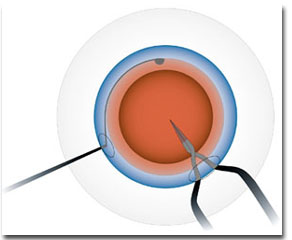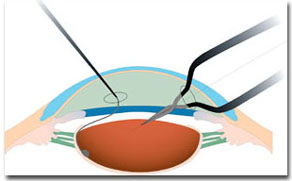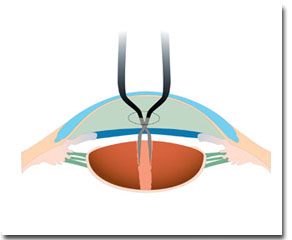| |
Microchirurgia della cataratta: per un intervento sicuro e personalizzato vai su
www.lacataratta.it
Bimanual Instant Cracking
Since 1970, when Charles Kelman introduced phacoemulsification in 1970, modern cataract
surgery has been a continuous quest for the most fitsuitable methods to reduce ultrasound
and surgical times necessaryrequired for lens removal. 1, 2 Reducing ultrasound
time means reducing the damagedamages to a unique and irreplaceable structure: -
the corneal endothelium. TheAkahoshi's pre-chop technique of Akahoshi is based on
the accurate study of the lens anatomy and of its possible division lines, and was
originally a monomanual technique. In 1998 Dr. Carlo Vanetti has developed a bimanual
version of this technique, called Bimanual Instant Cracking (BIC). It was called
Bimanual to highlight the simultaneous use of two instruments: the nucleus holder
for immobilization of the lens, and the cracking forceps. The nucleus holder is
a blunt hook with a double curve, built to follow the lens convexity, and featuring
a round, atraumatic tip. The holder makes it possible to immobilize safely the nucleus
during the cracking phase, at the same time warrantwhile ensuring complete lens
visualization. The cracking forceps feature crossed arms and slim, sharpened tips
to penetrate easily in the central portion of the nucleus. After the usual viscoelastic
injection, complete capsulorhexis and hydrodissection, viscoelastic is again reinjected
to offer optimal visualization and stability of the anterior chamber. It is essential
to prevent nuclear rotation in order to achieve a better visual control.
|
|

(Figures 1)
Bimanual Instant Cracking (BIC). Preparation for cracking: viscoelastic injection,
continuous curvilinear capsulorhexis, hydrodissection, nuclear rotation, and repeated
viscoelastic injection

(Figures 2)
Bimanual Instant Cracking (BIC). Insertion of forceps deep in the nucleus, while
nucleus holder sustains and immobilizes the nucleus.

(Figures 3)
Bimanual Instant Cracking (BIC). First cracking.
|
With this goal, the holder is inserted through the side port, and placed at 6 o'clock
under the anterior capsule to stabilize the nucleus, prevent its tilting and make
possible aensure deep penetration of the cracking forceps tips
(Figures 1).
Thereafter, the cracking phase takes place: the forceps are gently inserted into
the central nucleus, with an angle of 30°at a 30° angle
(Figures 2).
Then the forceps are opened to create a full-thickness nucleus fracture
(Figures 3).
|
|
|
|
|